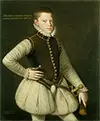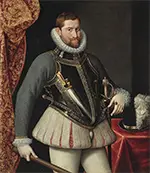Rudolf II: King of Germany, Holy Roman Emperor
Rudolf II was King of Germany and Holy Roman Emperor for a time in the late 16th Century and early 17th Century. He was born on July 18, 1552, in Vienna. His father was the future Holy Roman Emperor Maximilian II, and his mother was Maria of Austria. Rudolf was their oldest son and so was heir apparent to Maximilian's various thrones. 
The first of those crowns came in 1562, when Rudolf was 10. His father gained the title King of the Romans, which was really King of Germany. Maximilian gained the title King of Hungary and Croatia the following year and then achieved his lifelong dream of ascending the imperial throne in 1564. Rudolf's mother, Maria, was the daughter of Charles V, who was Holy Roman Emperor as Rudolf was growing up. Charles was also King of Spain, and it was in that country that Rudolf spent his teenage years. He returned, age 19, to the Austrian court in Vienna. Maximilian succeeded in having Rudolf crowned King of the Romans in 1575. The youth also gained the throne of Bohemia in that same year; this was three years after he had assumed the throne of Hungary. His father had gotten involved in a war of succession in neighboring Poland and died while making invasion plans. Rudolf immediately succeeded him as Holy Roman Emperor, on Oct. 12, 1576. Rudolf had a wide range of hobbies and interests and also had a number of suitors. He never married. At times, he suffered from mental problems. In 1583, Rudolf moved the imperial court to Prague and indulged in his prime hobby of collecting paintings. He spent large sums of money on works by famous artists, hanging them in his castle and spending long periods of time admiring them. He also assembled a large collection of sculptures and gadgets, made for him or bought by him, and populated a botanic garden and a menagerie of exotic animals. He had a keen appreciation of science and collected many clocks, telescopes, and other scientific devices. He was as well a patron of the famous astronomers Tycho Brahe and Johannes Kepler. 
Rudolf also set about trying to unite Europe under the banner of Christianity, as had been attempted during the Crusades a few centuries earlier. Christians by this time were quite divided, with the rise of Protestantism consuming the reigns of his father and grandfather. In an attempt to light the Crusading fire, Rudolf entered into a war with the Ottoman Empire, that lasted from 1593 to 1606 and ended only when Rudolf's younger brother, Matthias, had hammered out a peace agreement with the Ottomans. Rudolf had lost credibility with many of his subjects, including powerful nobles, by this time, and he had to hand over the thrones of Austria and Hungary to Matthias. He included the Bohemian crown two years later, after trying to play both sides of the Catholic-Protestant division and succeeding only in alienating both Bohemian Catholics and Bohemian Protestants. Further, in 1611, Matthias led an army into Rudolf's castle in Prague and held the emperor prisoner. By this time, Matthias was clearly the power behind the throne. Rudolf, thus imprisoned and stripped of his effectiveness, died, on Jan. 20, 1612. He was 59. His brother succeeded him a few months later. |
|
Social Studies for Kids
copyright 2002–2024
David White




